
Happy Friday, GPODers!
It seems that a lot of you are having a banner spring this year. From flushes of fabulous flowers to big and bright new foliage growth, and even some early-season edibles, we’ve seen just about everything a spring garden has to offer. We continue that theme with first-time contributor Susan Buckley in Idaho. Susan’s garden is at an elevation of 5,500 feet, so she deals with a pretty harsh winter, but that can make spring even more exciting and awe-worthy. A particularly impressive spring display this year is what encouraged her to finally send us some photos.
Hello. I have enjoyed your magazine for years but have never submitted photos; however, this spring has been so beautiful I thought I’d send a few in.
I garden in Zone 5b in Idaho. Our elevation is 5,500 feet. We have three months of snow and below-zero temperatures, then a slow thaw followed by a riotous spring. Summer brings intense sun, drought, and cool nights.
Our house is in a wooded area not far from a river. We are surrounded by massive cottonwoods, quaking aspen (Populus tremuloides, Zones 1–6), chokecherry (Prunus virginiana, Zones 2–7), and native dogwood (Cornus florida, Zones 5–9). I’ve been building and tending these gardens for 15 years. It’s a real joy to marvel at the beauty nature has made and to add a few pockets of non-native horticultural bling.
Elk and deer are frequent visitors, so I am careful about my plant choices. I have about 120 peonies (I can’t help myself), lots of daffodils, hellebores, bleeding heart, nepeta, monarda, salvia, spiraea, ornamental grasses, and dogwood. Lilies do well if I hit them with deer repellent once or twice. A few times a year we get a moose or two. They can eat whatever they want; I don’t mess with them.
Here are a couple of recent photos.
—Susan Buckley
 ‘Gold Heart’ (Dicentra spectabilis ‘Gold Heart’, Zones 3–9) and hellebores in my shade garden, my serene, low-maintenance garden ❤️
‘Gold Heart’ (Dicentra spectabilis ‘Gold Heart’, Zones 3–9) and hellebores in my shade garden, my serene, low-maintenance garden ❤️
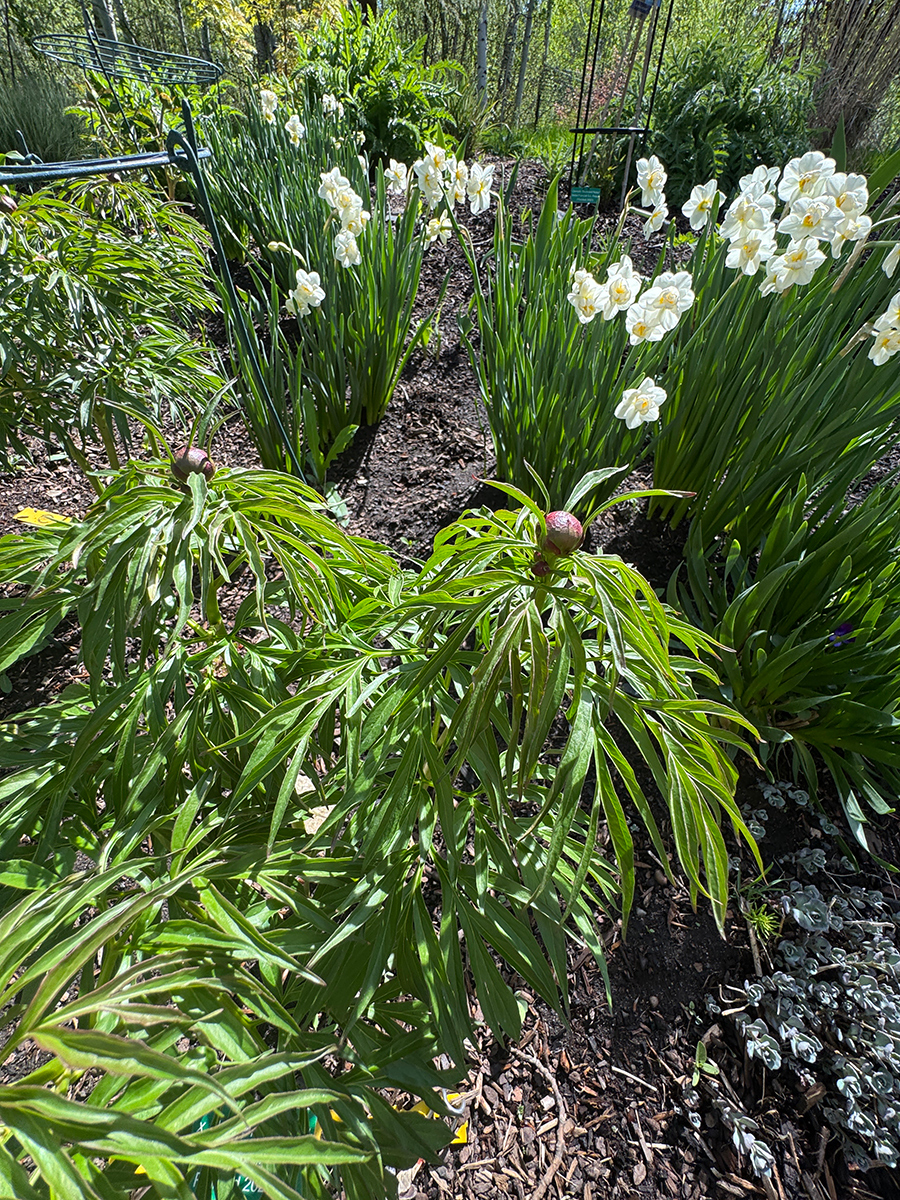 New this year is ‘Merry Mayshine’ peony (Paeonia × lactiflora ‘Merry Mayshine’, Zones 3–7). I love the almost fern-like leaves.
New this year is ‘Merry Mayshine’ peony (Paeonia × lactiflora ‘Merry Mayshine’, Zones 3–7). I love the almost fern-like leaves.
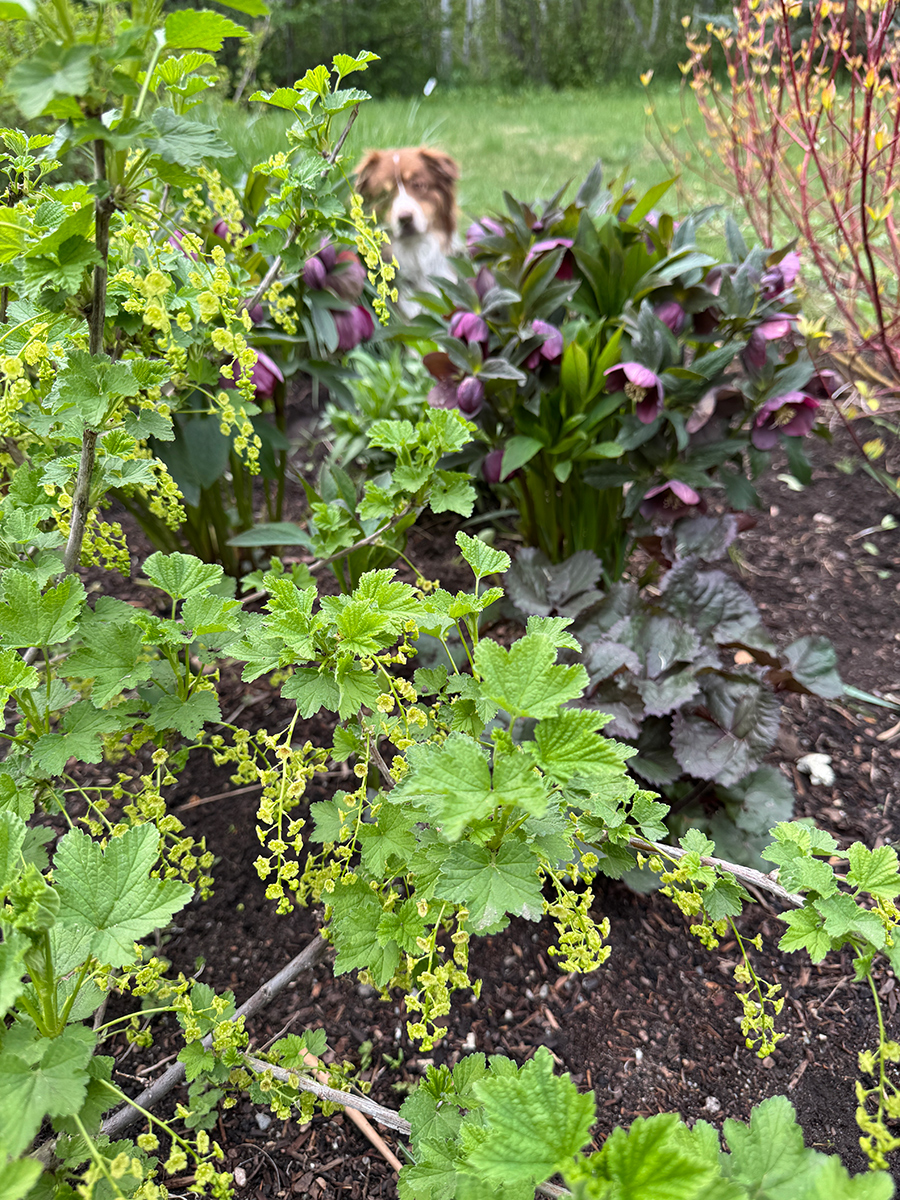 A blooming Pink Champagne currant (Ribes rubrum ‘Champagne Pink’, Zones 3–7) plays well with a purple hellebore, the round blackish leaves of ‘Othello’ ligularia (Ligularia dentata ‘Othello’, Zones 3–8), and the red stems of Neon Burst™ dogwood (Cornus alba ‘Byboughen’, Zones 2–7), a wonderful shrub that brings color to the yard all year long.
A blooming Pink Champagne currant (Ribes rubrum ‘Champagne Pink’, Zones 3–7) plays well with a purple hellebore, the round blackish leaves of ‘Othello’ ligularia (Ligularia dentata ‘Othello’, Zones 3–8), and the red stems of Neon Burst™ dogwood (Cornus alba ‘Byboughen’, Zones 2–7), a wonderful shrub that brings color to the yard all year long.
 These are emerging leaves of a young ‘North Wind’ maple (Acer × pseudosieboldianum ‘IslNW’, Zones 4–7), a hybrid of a Japanese maple and a Korean species. Its leaves are bright red in the spring. The elk have made this barrier a necessity until the tree’s branches are out of reach. The tree is worth the wait.
These are emerging leaves of a young ‘North Wind’ maple (Acer × pseudosieboldianum ‘IslNW’, Zones 4–7), a hybrid of a Japanese maple and a Korean species. Its leaves are bright red in the spring. The elk have made this barrier a necessity until the tree’s branches are out of reach. The tree is worth the wait.
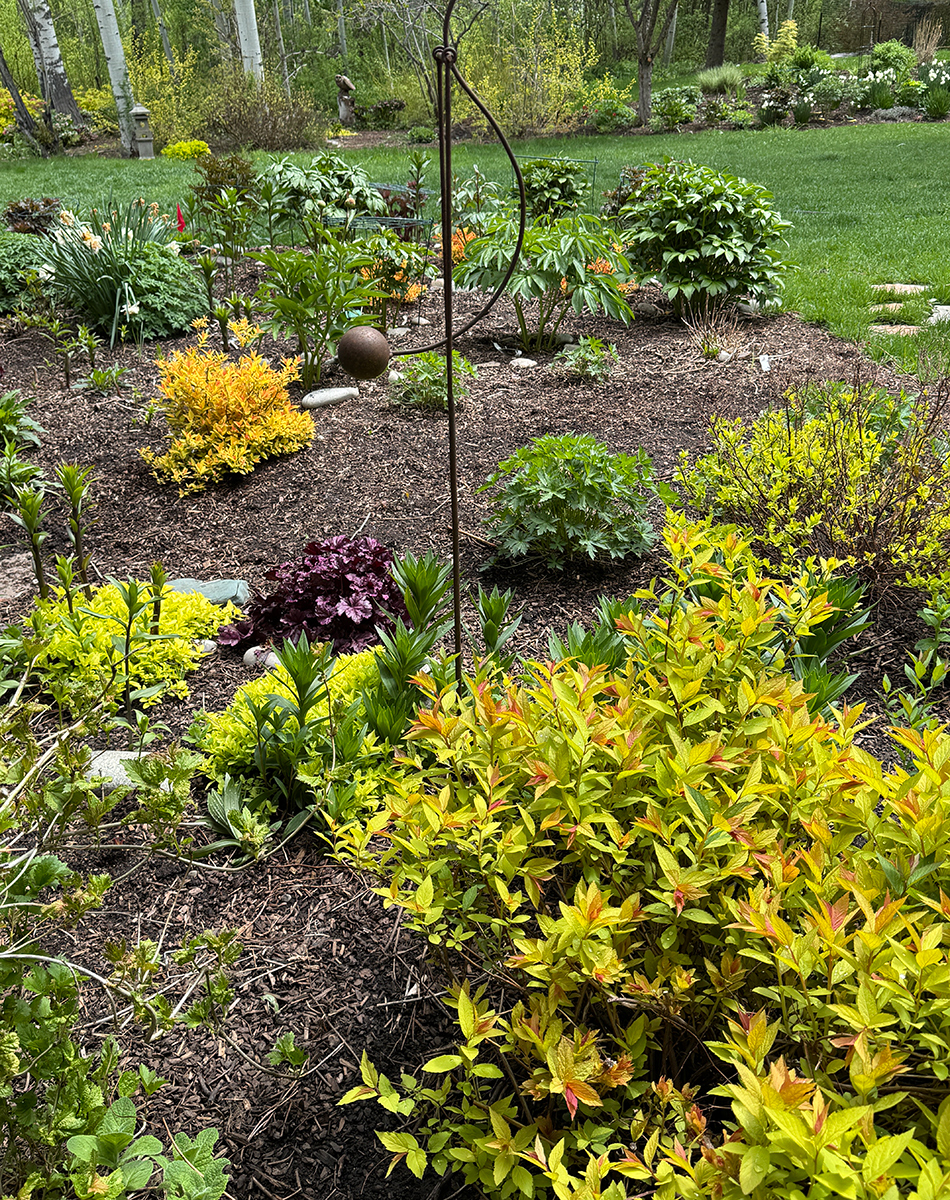 I love spiraea. They ask for nothing but sun and occasional water and throw pink, white, or red flowers against foliage in tones of green, blue, red, or gold. This bed is only a few years old and needed a pop of yellow. In the foreground is the ever-reliable ‘Goldflame’ (S. × bumalda ‘Goldflame’, Zones 4–9). To the middle left is Double Play Big Bang (S. japonica ‘Tracy’, Zones 3–9) and beyond, among the peonies, are a few Double Play Candy Corn (S. japonica ‘NCSX1’, Zones 4–8), tiny but bright.
I love spiraea. They ask for nothing but sun and occasional water and throw pink, white, or red flowers against foliage in tones of green, blue, red, or gold. This bed is only a few years old and needed a pop of yellow. In the foreground is the ever-reliable ‘Goldflame’ (S. × bumalda ‘Goldflame’, Zones 4–9). To the middle left is Double Play Big Bang (S. japonica ‘Tracy’, Zones 3–9) and beyond, among the peonies, are a few Double Play Candy Corn (S. japonica ‘NCSX1’, Zones 4–8), tiny but bright.
Thank you so much for sharing your delightful array of spring plants with us, Susan! This has been a wonderful introduction to your garden, but I sincerely hope that your first submission is not your last and we get to see even more from your garden this year.
Now that Memorial Day has come and gone, we’re on the fast track to summer and the last blooms of spring will be faded before we know it. While you’re out enjoying your spring garden this weekend, be sure to take some photos to capture this fleeting beauty, and consider sharing them with Garden Photo of the Day! Follow the directions below to submit photos via email, or send me a DM on Instagram: @agirlherdogandtheroad.
We want to see YOUR garden!
Have photos to share? We’d love to see your garden, a particular collection of plants you love, or a wonderful garden you had the chance to visit!
To submit, send 5–10 photos to [email protected] along with some information about the plants in the pictures and where you took the photos. We’d love to hear where you are located, how long you’ve been gardening, successes you are proud of, failures you learned from, hopes for the future, favorite plants, or funny stories from your garden.
Have a mobile phone? Tag your photos on Facebook, Instagram or Twitter with #FineGardening!
Do you receive the GPOD by email yet? Sign up here
Fine Gardening Recommended Products

The Regenerative Landscaper: Design and Build Landscapes That Repair the Environment
Fine Gardening receives a commission for items purchased through links on this site, including Amazon Associates and other affiliate advertising programs.
2024 Nautilus Award Gold Medal Winner! This awe-inspiring guide weaves together permaculture design, food resiliency, climate adaptation, community organizing, and indigenous wisdom that you can implement in your own backyard.
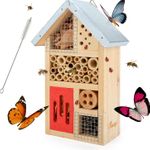
Niteangel Natural Wooden Insect Hotel, Garden Insect House for Ladybugs, lacewings, Butterfly, Bee, Bug
Fine Gardening receives a commission for items purchased through links on this site, including Amazon Associates and other affiliate advertising programs.
The insect nest box provide a safe environment where garden creatures can shelter, hibernate and lay their eggs, the insect house can also keep insects from entering your warm room. The insect hotel makes it easy to find and observe fascinating creatures. the butterfly, bees and ladybugs can use this product as habitat. Dry wood and Bamboo can be home to many insects such as ladybirds and lacewings which eat aphids and help keep your plants pest-free. the insect hotel improve the growth of plants in your yard by attracting beneficial insects. The iron design on the top can keep the insect house from rainwater. Let the insect house have a longer useful life and make the insects more comfortable. If you only have a balcony or yard, the hanging garden shelter is ideal as it provides a choice of suitable habitats in a small area.
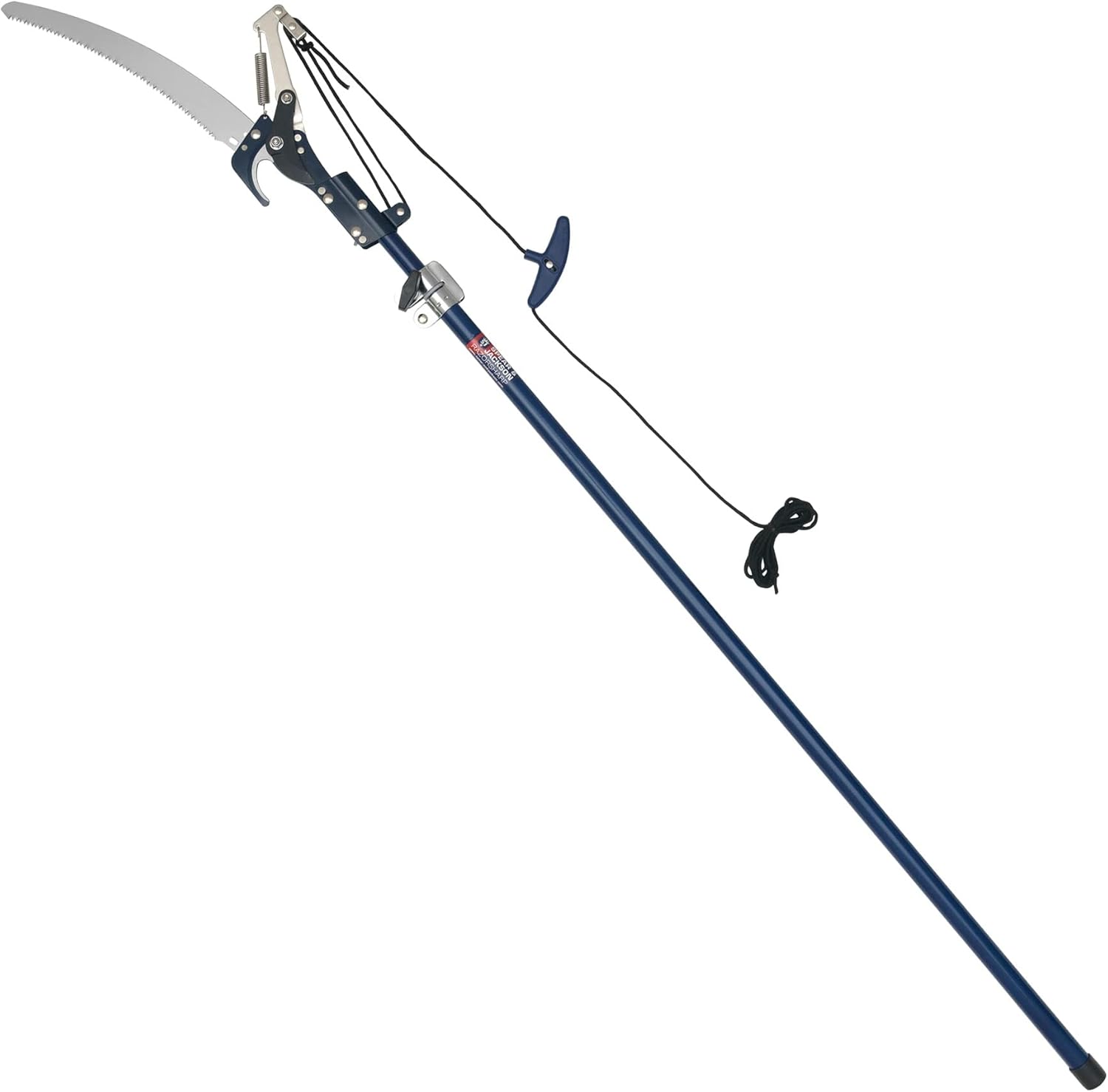
Spear & Jackson 4930FZ Razorsharp Telescopic Tree Pruner
Fine Gardening receives a commission for items purchased through links on this site, including Amazon Associates and other affiliate advertising programs.
Telescopic tree pruner with SK5 carbon steel blade which stays sharper for longer. Variable length telescopic handle extends up to 92 Inch (2340mm). Lopper for cutting branches up to 1.2″ (30mm). 13 inch (330mm) saw is ideal for cutting thicker branches. Supplied with a long cord and pull-action handle. Part of the Razorsharp Advantage collection, the obvious choice for gardeners who demand and expect precise, powerful performance. “Grow Your Own” Great British Growing 2020 Award Winners.








